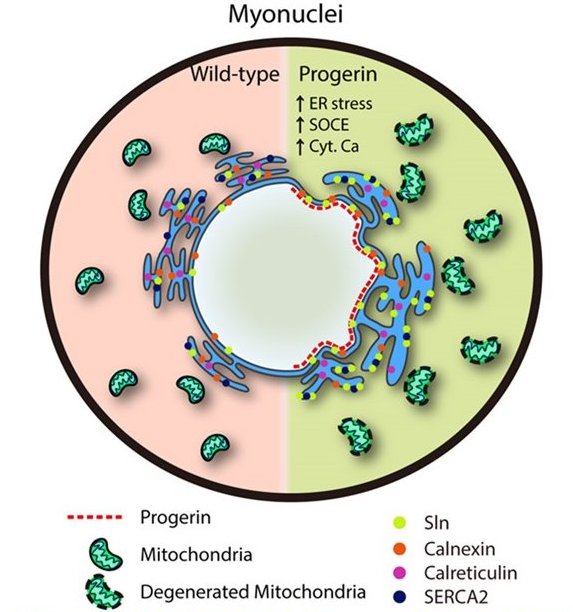 Mutations in lamin A (LMNA) are responsible for a variety of human dystrophic and metabolic diseases.Dr. Ya‐Hui Chi from the Institute of Biotechnology and Pharmaceutical Research has previously reported the accumulation of progerin, the lamin A mutant protein that causes Hutchinson–Gilford progeria syndrome (HGPS) and an inner nuclear membrane protein SUN1 (SAD1‐UNC84 domain protein 1) contributes to the dystrophic appearance of laminopathies. However, how mutations in the ubiquitously expressed lamin A give rise to clinically unrelated pathologies affecting specific tissues remains unknown. Dr. Chi and team therefore, developed a mouse model in which human progerin, the lamin A mutant protein that causes Hutchinson–Gilford progeria syndrome (HGPS) is conditionally overexpressed in muscle and then explored the physiological consequence of this disease‐causing lamin A mutant and the association with sarcoplasmic reticulum (SR)/ endoplasmic reticulum (ER) function.
Mutations in lamin A (LMNA) are responsible for a variety of human dystrophic and metabolic diseases.Dr. Ya‐Hui Chi from the Institute of Biotechnology and Pharmaceutical Research has previously reported the accumulation of progerin, the lamin A mutant protein that causes Hutchinson–Gilford progeria syndrome (HGPS) and an inner nuclear membrane protein SUN1 (SAD1‐UNC84 domain protein 1) contributes to the dystrophic appearance of laminopathies. However, how mutations in the ubiquitously expressed lamin A give rise to clinically unrelated pathologies affecting specific tissues remains unknown. Dr. Chi and team therefore, developed a mouse model in which human progerin, the lamin A mutant protein that causes Hutchinson–Gilford progeria syndrome (HGPS) is conditionally overexpressed in muscle and then explored the physiological consequence of this disease‐causing lamin A mutant and the association with sarcoplasmic reticulum (SR)/ endoplasmic reticulum (ER) function.
Dr. Chi and team demonstrated that muscle‐specific overexpression of progerin was sufficient to induce muscular dystrophy and alter whole‐body energy expenditure, leading to premature death. The team found sarcolipin (Sln), an ER‐associated protein involved in heat production, is upregulated in progerin‐expressing and Lmna knockout (Lmna-/-) skeletal muscle. The depletion of Sln accelerated the early death of Lmna-/- mice. A further examination at the molecular level revealed that progerin recruits Sln and Calnexin to the nuclear periphery. Furthermore, progerin‐expressing myoblasts presented enhanced store‐operated Ca2+ entry, as well as increased co‐localization of STIM1 and ORAI1. These findings suggested that progerin dysregulated calcium homeostasis through an interaction with a subset of ER‐associated proteins, resulting in thermogenic and metabolic abnormalities.
Citation: Wang, WP; Wang, JY; Lin, WH; Kao, CH; Hung, MC; Teng, YC; Tsai, TF; Chi, YH. Progerin in muscle leads to thermogenic and metabolic defects via impaired calcium homeostasis. Aging Cell. 2020 Feb;19(2):e13090.
